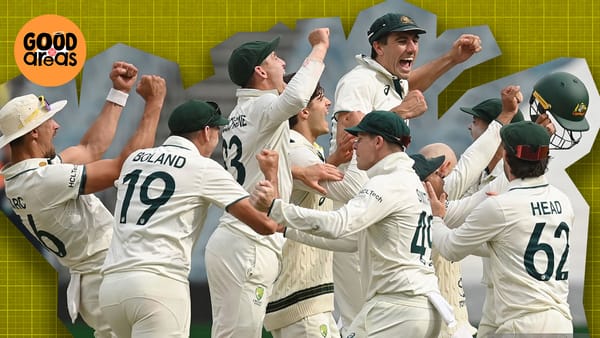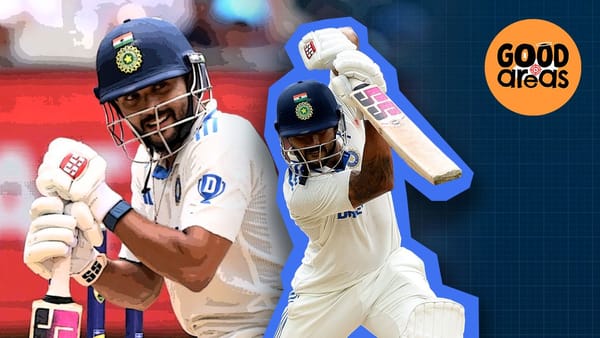Cricket talent; A journey
Two trips to the Oval, with a diversion to the Grange.
The new series of Double Century is under way. It’s on the crowd pleasing topic of when teams first beat England.
The Oval, 2009. The English Women were up against the Australians. The Aussies did well, making 163.
Sarah Taylor and Charlotte Edwards made little in response, and for the start of the seventh over Beth Morgan came out to bat with Clare Taylor. Morgan played a quality innings, but Taylor used a scalpel.
At that point, Taylor was the best batter in the women's game. She had this kind of homespun technique, almost more like a hockey player. Most women then looked like cricket manuals come to life. And so Taylor was something clearly different.
She played like she wanted to make runs, not look right.
Taylor did that throughout the entire innings. There were mistakes from the Australians, it was clear they just hadn't played much T20, and they couldn't change things up. But it was also about the larger playing surface. Taylor and Morgan would hit the spots in between sweepers and hustle back for twos again and again. The Australian fielders didn't have the arms or tactics to make it stop. And so England won with a few balls and eight wickets to spare without ever hitting that many boundaries.
Women's cricket of that era was amateur. Taylor had a job and obsessed over cricket in her spare time. She stood out that day - and often - because she wasn't textbook, and she was an incredible runner in a sport that was plagued by runouts. She had a game that seemed out of time.
But even if Taylor was the best batter at that point, she wasn't the most talented. She averaged 40 in Tests and ODI, and that was her best T20 innings by a distance. And in her era were Mithali Raj and Ellyse Perry. They're God-Tier talents.
That Taylor was so good was down to her maximising her natural ability in a flawed system. She wasn't the most talented, but she found a way to unlock it that others could not.
🎙 New Wagon Wheel 🎙
— Jarrod Kimber (@ajarrodkimber) 8:32 AM ∙ Jul 31, 2021
Hundred graphics
Indian selection
Offspin v SLA
300+ scores in Tests
And is reverse swing disappearing in a haze of sandpaper
anchor.fm/redinker/episo…
We focus on talent in sport, but while much of this is natural, two parts of it are completely in our control. Finding and developing it. In 2009, there was little of either in the women's game.
Cricket has been far behind in finding talent. Selectors were amateur and usually out of step with the game. There is an entire industry around mock drafts, talent scouts and General Managers in US sport. Cricket is just slowly waking up to the fact that 75-year-old former players who only watch first-class cricket when someone asks them to chat at a function aren't the best way of selecting teams.
But US or Football systems only work if the people you want to scout are playing cricket already. It's easy to find heaps more talented women now than ten years ago because so many more are playing.
And this isn't just a women's issue; it's exactly the same for the associates. If you can find more players, the chances are you'll mind more that are better.
This is perhaps why one of cricket's first public scouting networks is from Scotland. A country that has always produced a lot of cricketers compared to other non-Test playing nations. But struggled to develop them.
Because that is the other part. If you find an incredibly talented player, but you have no professional support structure, they will occasionally perform brilliantly. Still, chances are it won't be consistent unless they're a self-taught freak.
Look at the Scottish team. It's not that this generation of Scottish cricketers have the magic cricket gene. There might be more of them, but the players aren't coming out of their mums more talented than previous Scots. They've had access to county cricket, Scottish professional programs, experienced coaches and more international matches than ever before. Cricket is no longer an amateur pastime their best players do on weekends. It is a job, and they're better. And this isn't just a Scottish thing; the overall level of associate cricket is improving. Whether it's access to better coaches (like Jonty Rhodes leading Sweden), the ability to quit their day jobs, or just playing more organised cricket, teams outside the major nations are just getting better.
And that's how I've felt watching the women's matches in the hundred so far. They're just better. They bowl faster, hit longer and throw harder. The running between the wickets has taken an enormous step.
On sixes alone it's clear things have changed. Maximums were like unicorns in women's cricket in 2009; one every 126 balls. Not quite one a match. Now they're just a normal part of the game, in the Hundred it’s one every 62 balls according to Hypocaust. There was a moment earlier in this tournament where Danni Wyatt played a lofted square drive for six.
But it's the upskilling of the entire game. The throws in from the deep - from even the most average fielders - these days don't allow for easy twos, let alone an afternoon of them.
You can hear Izzy Westbury chat to me about how the women’s game has changed so much here.
Episode 73 is @izzywestbury on domestic women's cricket.
— Jarrod Kimber (@ajarrodkimber) 1:48 PM ∙ Jul 31, 2021
We talk professionalism, gender pay gap, growing new markets and that women's cricket has improved so much that Izzy wouldn't get a game anymore.
For years when I wrote about women or associate teams, my comments and replies had people telling me that they'd never be good at cricket. This was a really big belief. That somehow being born with a penis in an established cricket nation made you better at the sport. That thinking has pretty much gone. But it never made sense, as those men's Test teams got better over time, often developing slow. Nothing happens magically.
When Scotland beat England - which you can listen all about on Double Century - it was the culmination of a bunch of factors.
Double Century SE3EP8 on Scotland
— Jarrod Kimber (@ajarrodkimber) 1:41 PM ∙ Jul 31, 2021
When Scotland Swept England
Their players had faced top quality wrist spin before they stepped up against Adil Rashid. They were used to quicker bowlers in associate cricket, so Mark Wood and Liam Plunkett's extra pace didn't bother them. And when Jonny Bairstow and Moeen Ali started humping them around the field, they had the experience of being in a bunch of big high-pressure matches.
And at the Oval this year it was the first Hundred match between Invincibles and Manchester Originals. It wasn't just another cricket match but a showpiece of a sport in rapid evolutionary ascent.
Their level of cricket was far beyond what seemed possible 12 years ago. The strategies, power, fielding, running, hitting, bowling, all of it. It felt like a different sport than that game at the Oval over a decade back.
And this is the weird thing, this Hundred match was a domestic tournament with some quality overseas imports. That Australia England match in 2009 was a World Cup semi-final. And there is no doubt the Hundred quality wasn't just better; it was the difference between a well run two against a weak throwing arm and a six over point.
The talent hasn’t changed; the game has.




